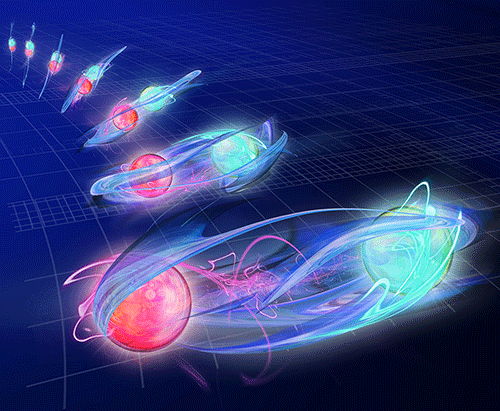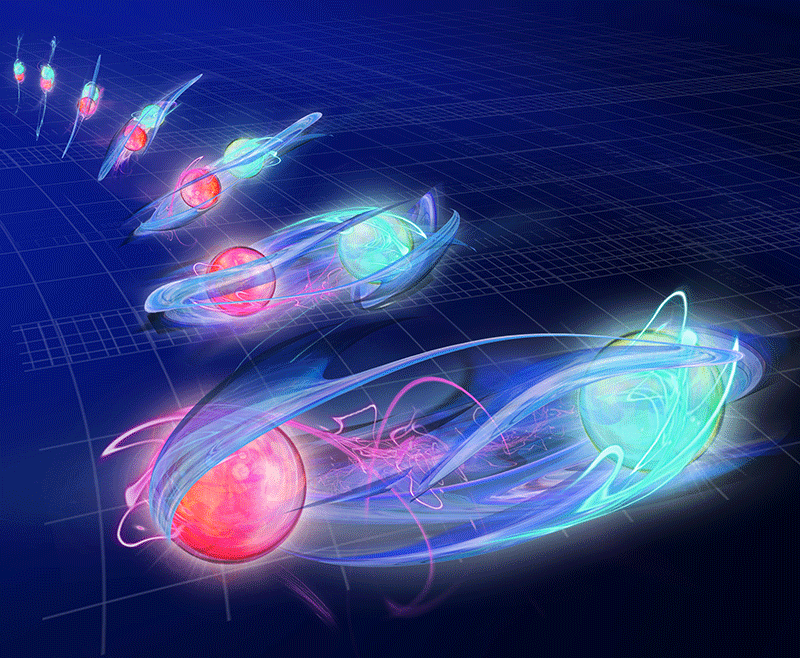Meetings: Highlights from DAMOP 2016
Just over 1200 scientists gathered in Providence, Rhode Island, for the annual meeting of the APS Division of Atomic, Molecular, and Optical Physics (DAMOP). We heard about the burgeoning field of atomtronics, quantum gas microscopes, and the quest to entangle thousands of atoms. Here are two stories from the conference that capture the quantum and classical ends of the spectrum.
–Jessica Thomas
Quantum Simulation Tackles Particle Physics
Quantum computers have a new triumph to brag about, and it’s one that would make a particle physicist proud. Using four calcium ions, a team in Austria simulated an electron-positron pair popping out of the vacuum. Although classical computers can already handle this kind of pair production, the work might lead to new ways of studying high-energy phenomena that defeat even the most powerful supercomputers.
The crux of any quantum simulation is mapping a system that is tough to calculate onto one that can be controlled in the lab. Rainer Blatt, who is from the University of Innsbruck, Austria, and led the experiments, collaborated with theorists at Innsbruck to find a practical and efficient mapping between a lattice gauge theory and the internal states of ions in a trap.
Blatt likened this theoretical work to writing a computer program—albeit for a very unique kind of quantum computer. He and his colleagues then had to translate it into a lower level “assembly language,” a series of laser pulses, whose frequency and duration control the internal states of trapped ions.
Blatt’s group performed 222 distinct operations on a row of four ions, whose states at each time step encoded the particle density on the simulated lattice. Their scheme is an example of digital quantum simulation, which breaks a dynamic process into a series of discrete steps. This approach allows for error corrections along the way and is very precise. But it can require a prohibitively large number of steps for complex simulations. Blatt, who says the new simulations are “by far the most complicated we’ve run,” thinks that an analog approach, in which the lab system simply mimics the real system, might ultimately be the way to outpace classical computers.
See more about the simulations in this Nature paper.
Reinventing the Classical Mechanics Classroom
In a year-long experiment, Lincoln Carr, a theoretical physicist at the Colorado School of Mines, set out to resuscitate graduate level classical mechanics—a course that many universities have abandoned. Traditional lectures and written exams weren’t preparing students for research careers, so he scrapped both and decided to have his students teach each other and themselves.
Carr structured the course like a series of small research projects. In a typical 80-minute class, students might discuss a new topic, critique each other’s “toy problems,” and present a summary of the new concepts. In place of one textbook, students relied on the same resources as researchers: a lot of books, published papers, and the internet. They wrote and graded each other’s homework problems, and they designed, built, and performed experiments instead of taking exams. To make time for the discussion and experiments, Carr limited the syllabus to just three specific projects: coupled modes; the transition from discrete to continuum models; and the period doubling route to chaos.
Carr is the first to admit that his experiment has little data and his analysis is mostly anecdotal. Still, he views the project as a success because his students developed the skills they actually need to do research: how to think on their feet, analyze data, work collaboratively, and learn from being wrong. And thanks to the class, his university isn’t putting grad-level classical mechanics on the chopping block. In fact, two of his colleagues have applied for grants to develop teaching methods for other traditional courses, such as solid-state physics and statistical mechanics.





